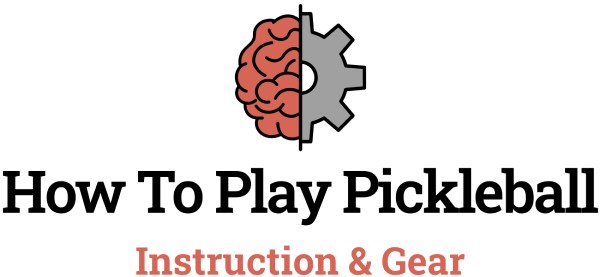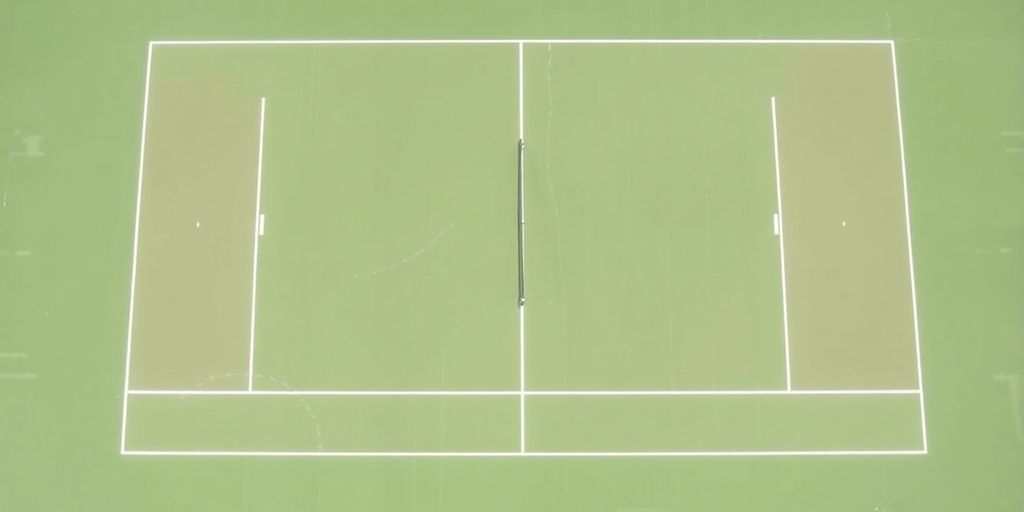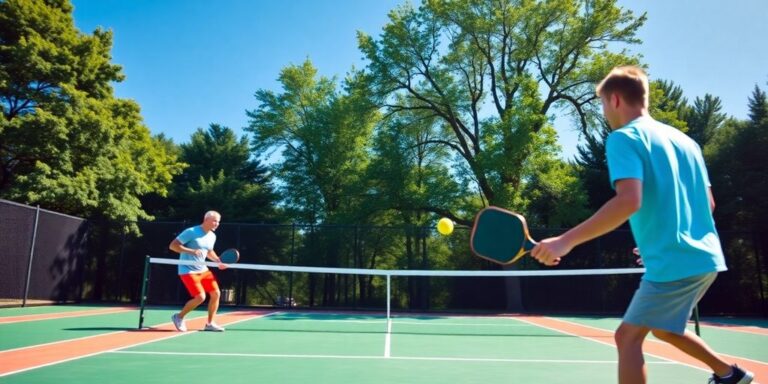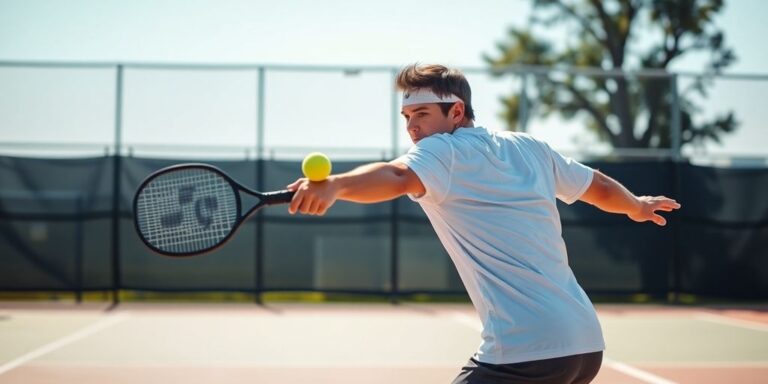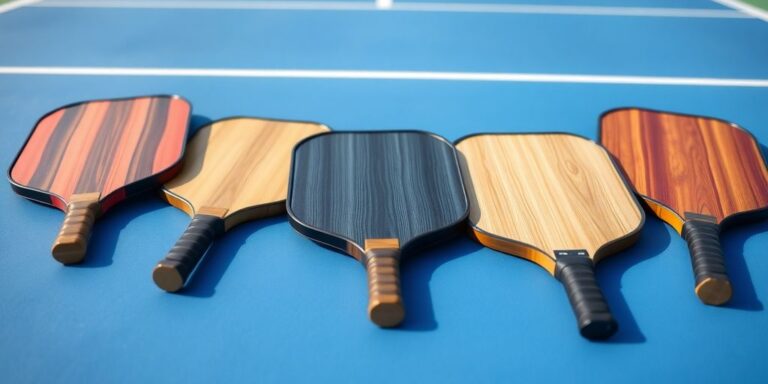If you’re getting into pickleball or just want to know more about the game, understanding the dimensions of a pickleball court is super important. This guide will walk you through everything you need to know—from the size of the court to how it affects gameplay. Whether you’re planning to play or set up your own court, this info will help you get the most out of your pickleball experience.
Key Takeaways
- A standard pickleball court is 20 feet wide and 44 feet long, suitable for both singles and doubles play.
- The court size is smaller than a tennis court but similar to a doubles badminton court, making it unique in the sports world.
- Key areas like the non-volley zone and service areas are vital for gameplay strategy.
- Setting up a court requires precise marking to ensure fair play and adherence to rules.
- Understanding court dimensions can help players adapt their strategies and improve their game.
Standard Dimensions of a Pickleball Court
Overall Court Size
Okay, let’s get right into it. A regulation pickleball court is 20 feet wide and 44 feet long. This size is the same for both singles and doubles play. It’s a pretty important thing to remember if you’re thinking about setting up your own court or just want to understand the game a bit better. The playing surface should ideally be 30 feet by 60 feet at the minimum, with a preferred size for tournament play of 34 feet by 64 feet. These dimensions ensure players have enough room to chase down every ball, making each game more dynamic and exciting.
Comparison with Other Sports
So, how does a pickleball court stack up against other sports? Well, it’s smaller than a tennis court size, which makes for a different kind of game. It’s closer in size to a badminton court, but even then, there are differences. The non-volley zone, or "kitchen," is a unique feature that you won’t find in tennis or badminton. This area extends 7 feet from the net on both sides. Understanding these comparative dimensions provides insight into how each sport requires different playing areas and emphasizes specific skills. It’s important for players to adapt to these unique space requirements when transitioning between sports.
Impact on Gameplay
The size of the court really changes how you play the game. You have to be quick, and your shots need to be precise. The smaller court means faster rallies and more action close to the net. Positioning becomes super important, and you have to think about where you are on the court all the time. The dimensions of a pickleball court are crucial for laying out a temporary or permanent court.
The court dimensions dictate the pace and style of play. Because the court is smaller, players need to react quickly and develop strategies that work in a confined space. This also means that dinking (soft shots near the net) and strategic placement are more important than raw power.
Here’s a quick rundown of the key dimensions:
- Overall Court: 20 feet x 44 feet
- Non-Volley Zone: 7 feet from the net on each side
- Service Areas: 10 feet wide and 15 feet deep
Knowing these measurements is key to understanding pickleball court dimensions and how they affect the game.
Breaking Down the Pickleball Court

The Service Zones
Okay, so when you’re looking at a pickleball court, the service zones are pretty important. These are the areas where you have to land your serve to start a rally. Think of them as the launchpads for each point. The dimensions of these zones can really affect how you serve. You can change the angle and speed, which then messes with how your opponent can return the ball. It’s all about strategy from the very first hit. You need to understand pickleball rules to play effectively.
Non-Volley Zone Specifications
Now, let’s talk about the non-volley zone, or as some people call it, "the kitchen." This is the area closest to the net where you can’t volley the ball. It’s there to stop players from just camping out at the net and smashing every return. Here’s what you need to know:
- It extends 7 feet from the net on both sides.
- Players can only enter the kitchen to play a ball that has bounced in the zone.
- You can’t volley a ball while standing in the kitchen, even if you jump from outside of it.
The non-volley zone adds a layer of strategy to the game. It forces players to be more thoughtful about their shots and court positioning. It’s not just about power; it’s about placement and timing.
Court Markings and Lines
Understanding the court markings is super important. It’s like knowing the rules of the road. Here’s a quick rundown:
- Baseline: The line at the back of the court. You serve from behind this line.
- Sideline: The lines on the sides of the court. They mark the boundaries of play.
- Centerline: This line divides the service areas. It helps determine where you should stand when serving.
- Non-Volley Line: Marks the start of the non-volley zone (the kitchen). It’s 7 feet from the net.
Accurate court dimensions are key for fair play. If the lines are off, it can lead to arguments and unfair advantages. Make sure you know where you are on the court!
Understanding Court Layout for Players
Court Sections Explained
Okay, so you’re standing on the pickleball court. What now? It’s not just a big rectangle; it’s divided into specific zones that dictate where you can move and when. Understanding these sections is key to playing strategically. The court is split into halves by the net, and each half is further divided into the non-volley zone (or "kitchen"), and the service areas.
- The baseline is where you serve from.
- The sidelines define the width of the court.
- The kitchen is the area closest to the net where you can’t volley.
Importance of Court Dimensions
Court dimensions aren’t arbitrary; they directly impact gameplay. The size of the court influences everything from shot selection to player positioning. A smaller court means quicker reactions and less ground to cover, which favors certain playing styles. Knowing the exact dimensions helps you anticipate your opponent’s moves and plan your own shots more effectively. For example, the total playing area is important for players to perform effectively.
Adapting to Different Court Sizes
While regulation courts are standard, you might encounter variations, especially in recreational settings. Maybe the lines are a little faded, or the court is slightly smaller than regulation. Adapting to these differences is part of the game. If the court is smaller, you might need to adjust your serve or be prepared for faster rallies. If you’re playing on a temporary court, make sure the court markings are clear.
Playing on different court sizes can actually improve your game. It forces you to think on your feet and adjust your strategies. It’s like a mental workout that translates to better performance on any court, anywhere.
Setting Up a Pickleball Court
Materials Needed
Okay, so you want to set up your own pickleball court? Awesome! First, you’ll need to gather your supplies. Accurate measuring tools are a must. You can’t just eyeball it! You’ll also need:
- Boundary markers (cones or something similar work in a pinch).
- A regulation net and net posts (permanent or temporary, depending on your setup).
- Paint or tape designed for marking surfaces (sidewalk chalk is NOT going to cut it).
- A measuring tape (at least 50 feet).
Don’t skimp on the quality of your materials. A wobbly net or faded lines will make the game less fun. Also, consider the surface you’re working with. You might need different types of tape or paint depending on whether it’s asphalt, concrete, or a gym floor. If you’re converting a tennis court, you’ll need to think about how to mark the pickleball lines on tennis court without damaging the existing surface.
Marking the Court
Marking the court is where precision really matters. Here’s a basic rundown:
- Measure the overall court dimensions: 20 feet wide and 44 feet long. Mark the corners.
- Mark the baselines and sidelines: Use your measuring tape to ensure they’re straight and accurate. Apply your tape or paint carefully.
- Mark the non-volley zone (kitchen): This is 7 feet from the net on each side. Accuracy is key here!
- Mark the service areas: Divide each side of the court in half to create the service boxes.
Take your time and double-check your measurements. It’s way easier to fix a mistake now than to realize your court is wonky halfway through a game. A slightly off court can really mess with gameplay and strategy.
Temporary vs Permanent Courts
Deciding between a temporary and permanent court depends on your space, budget, and commitment to pickleball. Temporary courts are great if you don’t have a dedicated space or want to test out the game before committing. You can use tape and portable nets. Permanent courts, on the other hand, require more investment but offer a better playing experience. You’ll need to paint the lines and install permanent net posts. If you’re thinking about a backyard pickleball court, a permanent setup is the way to go. Consider these points:
- Temporary: Easy to set up and take down, good for shared spaces, lower cost.
- Permanent: More durable, better playing surface, requires dedicated space, higher initial cost.
If you’re setting up a temporary court, make sure the tape you use won’t damage the surface underneath. For permanent courts, consider the long-term maintenance requirements. Also, think about the impact on the surrounding area. Will a permanent court affect drainage or landscaping? If you’re looking for local pickleball clubs, a permanent court might be a good investment for your community.
Regulation and Non-Regulation Courts
Differences in Dimensions
Okay, so, when we talk about pickleball courts, there’s the official, by-the-book size, and then there are courts that… well, aren’t. A regulation pickleball court is 20 feet wide and 44 feet long [court dimensions](#0522]. That’s the standard, whether you’re playing singles or doubles. But sometimes you’ll find courts that are a little different. Maybe they’re squeezed into a smaller space, or someone just didn’t measure correctly. These non-regulation courts can change the game a bit.
Think of it like this:
| Feature | Regulation Court | Non-Regulation Court |
|---|---|---|
| Length | 44 feet | Varies |
| Width | 20 feet | Varies |
| Line Placement | Precise | May be off |
| NVZ (Kitchen) | 7 feet | Potentially different |
Usage of Non-Regulation Courts
So, why would anyone use a court that isn’t the right size? Well, sometimes it’s just about making do with what you have. Maybe you’re converting a space that wasn’t originally meant for pickleball, like a basketball court or a driveway. Or perhaps you’re just trying to fit a court into a backyard that isn’t quite big enough. Non-regulation courts can still be fun, but it’s important to know that the game might feel different. The non-volley zone might be a bit off, or the service lines might be in a weird spot. It’s all about adapting and having fun, but if you’re serious about improving your game, you’ll want to spend most of your time on a regulation court.
Benefits of Regulation Courts
Why bother with a regulation court? Because it gives you the most accurate and consistent playing experience. When you play on a court that’s the right size, you’re developing skills that will translate to any other regulation court. You’ll get a better feel for spacing, shot placement, and strategy. Plus, if you’re planning on playing in tournaments or competitive matches, you’ll need to be comfortable on a regulation court. Knowing your pickleball skill levels is important, and playing on the right court helps you improve.
Playing on a regulation court helps you develop a consistent game. It ensures that you’re practicing the right distances and angles, which is important for improving your skills and competing effectively. It also makes the game fairer and more enjoyable for everyone involved.
Comparative Dimensions with Other Sports
Tennis Court Size
Okay, so let’s talk tennis. Tennis courts are HUGE compared to pickleball courts. A singles tennis court is 27 feet wide and 78 feet long. Doubles? Even bigger. That’s a lot of ground to cover! This extra space changes the whole game. You’ve got more room for those long, drawn-out rallies and powerful serves. It’s a different kind of workout, for sure. The playing areas are much larger.
Badminton Court Size
Badminton is a bit closer in size to pickleball, but still different. A badminton court for doubles is 20 feet wide and 44 feet long. So, the length is the same as a pickleball court, but badminton courts are a bit narrower. This affects how you move and the strategies you use. You might find yourself closer to your partner more often in badminton than in pickleball. It’s interesting how those small changes in size can make such a big difference. Understanding these comparative dimensions provides insight into how each sport requires different space requirements and emphasizes specific skills. It’s important for players to adapt to these unique space requirements when transitioning between sports.
Unique Features of Pickleball
Pickleball has some unique features that set it apart. The biggest one is the non-volley zone, also known as "the kitchen." This area extends 7 feet from the net on both sides, and players can’t volley the ball while standing in it. This rule changes the game completely, forcing players to be strategic about their shots and court positioning. Plus, the smaller court size makes for faster-paced action and shorter rallies. It’s a fun, social game that’s easy to learn but hard to master. Finding a pickleball partner is easy because of the social nature of the sport.
Pickleball’s dimensions are key to its unique gameplay. The smaller court and the non-volley zone create a dynamic that blends elements of tennis, badminton, and ping pong, making it accessible and engaging for a wide range of players.
Here’s a quick comparison table:
| Sport | Court Dimensions (Width x Length) | Key Feature |
|---|---|---|
| Pickleball | 20 ft x 44 ft | Non-Volley Zone (The Kitchen) |
| Tennis | 27 ft x 78 ft (singles) | Larger court, emphasis on power and reach |
| Badminton | 20 ft x 44 ft (doubles) | Lighter racquet, emphasis on quick reflexes |
The Role of Dimensions in Strategy

Positioning on the Court
Court dimensions have a huge impact on where you stand and move. The smaller size of a pickleball court compared to a tennis court means you have less ground to cover, but positioning becomes even more important. You can’t just stand anywhere and expect to make the shot. You need to think about angles, your opponent’s likely shots, and how to control the non-volley zone.
- Knowing the exact measurements helps you anticipate your opponent’s moves.
- Effective positioning can cut off angles and force errors.
- Understanding court depth is key for dinking and drop shots.
Proper positioning isn’t just about standing in the right spot; it’s about anticipating the play and being ready to react. It’s about understanding how the court’s dimensions influence every shot and every movement.
Serving Strategies
Serving in pickleball isn’t just about getting the ball over the net; it’s a strategic opportunity. The dimensions of the service area dictate where you can legally serve from and where the ball needs to land. This impacts the type of serve you choose and the spin you put on the ball. A deep serve can push your opponent back, while a short serve can set up a favorable third shot. Mastering the pickleball serve is key to gaining an early advantage.
Defensive Play Considerations
Defensive play is heavily influenced by court dimensions, especially the non-volley zone (the kitchen). You can’t just camp out at the net and block everything. You need to be aware of your position relative to the kitchen line and your opponent’s ability to hit angles. Quick reactions and smart footwork are essential for effective defense. Understanding the court layout is crucial for defensive strategies.
- Knowing the court’s width helps you cover cross-court shots.
- Understanding the depth allows for better backpedaling and resets.
- The kitchen line dictates when you can volley, influencing your net play.
Here’s a simple table showing how court dimensions affect defensive strategies:
| Court Feature | Impact on Defense |
|---|---|
| Court Width | Dictates coverage for cross-court shots |
| Court Depth | Influences backpedaling and reset opportunities |
| Non-Volley Zone | Restricts volleying, affecting net play strategy |
Thinking about the future of pickleball, I wonder if court sizes will change to accommodate different playing styles or skill levels. It’s something to consider!
Understanding how different dimensions affect strategy is crucial for success. Each dimension, whether it’s time, resources, or market conditions, plays a unique role in shaping decisions. By recognizing these factors, you can create a more effective plan. Want to learn more about how to enhance your strategy? Visit our website for tips and insights!
Wrapping It Up
So there you have it! Understanding the dimensions of a pickleball court is pretty straightforward, but it makes a big difference in how you play. Whether you’re setting up a court in your backyard or just trying to get a better grasp of the game, knowing the size and layout is key. Remember, a standard court is 20 feet wide and 44 feet long, which is smaller than a tennis court but still gives you plenty of room to move. This knowledge not only helps you play better but also makes the game more enjoyable. So grab your paddle, hit the court, and have fun!
Frequently Asked Questions
What are the standard dimensions of a pickleball court?
A standard pickleball court is 20 feet wide and 44 feet long. This size is the same for both singles and doubles games.
How does a pickleball court compare to other sports courts?
A pickleball court is similar in size to a doubles badminton court but smaller than a tennis court, which is much larger.
What are the different zones on a pickleball court?
The court has specific zones like the service areas and the non-volley zone, which are important for how the game is played.
Can I set up a temporary pickleball court?
Yes, you can create a temporary court using cones and chalk to mark the lines, perfect for casual play.
Why are court dimensions important for pickleball?
Knowing the court dimensions helps players understand how to position themselves and develop strategies during the game.
Are there different types of pickleball courts?
Yes, there are regulation courts that meet official size requirements and non-regulation courts that might be smaller or set up for casual play.
